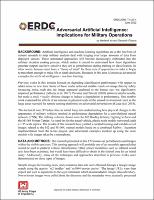Please use this identifier to cite or link to this item:
https://hdl.handle.net/11681/44640| Title: | Adversarial artificial intelligence : implications for military operations |
| Authors: | Yu, Harland F. Chopra, Saransh |
| Keywords: | Artificial intelligence Machine learning Target acquisition--Evaluation |
| Publisher: | Engineer Research and Development Center (U.S.) |
| Series/Report no.: | Technical Note (Engineer Research and Development Center (U.S.)) ; no. ERDC/GRL TN-22-1 |
| Abstract: | Artificial intelligence and machine learning algorithms are at the forefront of current research to help military analysts deal with triaging ever larger amounts of data from deployed sensors. These automated approaches will become increasingly embedded into the military decision making process, which makes it crucial to understand how these algorithms generate outputs and how sensitive they are to perturbations during training or classification. In other words, humans must have a ‘theory of mind’ for these sets of approaches in order to begin to trust them enough to make life or death decisions. Research in this area is known as adversarial examples for artificial intelligence / machine learning. Previous works in this domain focused on degrading classification performance with respect to added noise to new data. Some of these works achieved notable results on image data by subtly increasing noise, such that the image appeared unaltered to the human eye, but significantly impacted performance (Athalye et al. 2017). Povolny and Trivedi (2020) achieved similar results, but made a small visually obvious change to induce a degradation in performance. One notable work examined the effects of an increase in physical scale of the sensed environment (such as the large areas recorded for remote sensing platforms) on adversarial perturbations (Czaja et al. 2018). This technical note (TN) describes an initial foray into understanding how physical changes to the appearance of military vehicles resulted in performance degradation for a convolutional neural network (CNN). The military vehicles chosen were the M2 Bradley Infantry Fighting Vehicle and the M1064 Mortar Carrier. As stand-ins for the actual vehicle, plastic scale models were used, each a 1/35 scale replica. The results of this research have yielded a curated training and test data set of images related to the M2 and M1064, trained models based on a combined ResNet / Inception implementation from the Keras project, and adversarial examples mocked up using the scale models with images taken by a smartphone. |
| Description: | Technical Note |
| Gov't Doc #: | ERDC/GRL TN-22-1 |
| Rights: | Approved for Public Release; Distribution is Unlimited |
| URI: | https://hdl.handle.net/11681/44640 http://dx.doi.org/10.21079/11681/44640 |
| Appears in Collections: | Technical Note |
Files in This Item:
| File | Description | Size | Format | |
|---|---|---|---|---|
| ERDC-GRL TN-22-1.pdf | 2.96 MB | Adobe PDF |  View/Open |